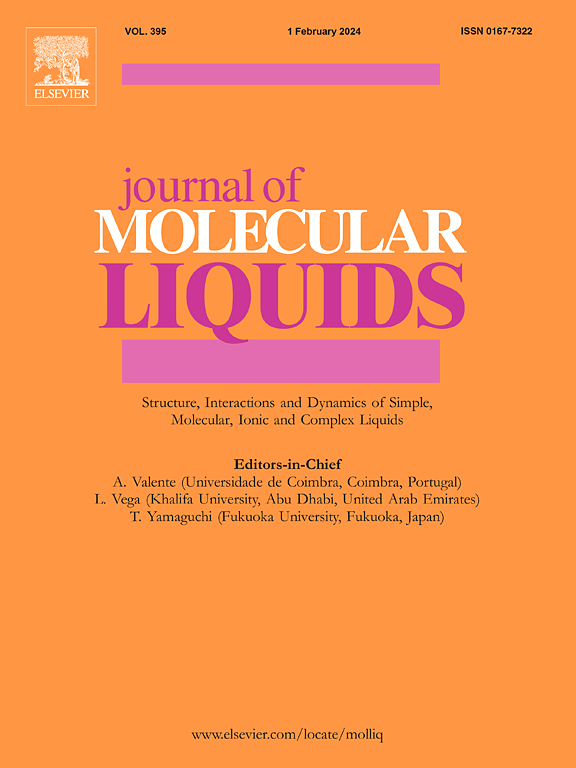Insights for photochemical mechanisms of acridine-1,8-diones: An experimental and theoretical analysis and first application for fluorescence detection of 2,4,6-trinitrophenol
IF 5.3
2区 化学
Q2 CHEMISTRY, PHYSICAL
引用次数: 0
Abstract
Acridine-1,8-diones are a type of conspicuous compound. However, only few works investigated the fluorescence properties even based on one or two isolated compounds. Here, eighteen acridine-1,8-diones were synthesized via our earlier pathway and the configuration, electronic properties and excited state properties of them were studied systematically by density functional theory (DFT) calculations and corresponding experiments. The reason why they have similar fluorescence emission wavelength and have quite different fluorescence emission intensity was investigated and explained. Among these compounds, YD-1 exhibited the best fluorescent behavior and was used to detect 2,4,6-trinitrophenylphenol (TNP) firstly. The quenching efficiency reached 90.7 %, detection limit was 0.23 μM, detection time was within 10 s and binding constant was as high as 5.3 × 104 M−1. This probe was also successfully applied in actual water sample and soil detection, as well as real-time detection of TNP through portable fluorescent strip and smartphone platform.

吖啶-1,8-二酮光化学机制的启示:实验和理论分析以及 2,4,6-三硝基苯酚荧光检测的首次应用
吖啶-1,8-二酮是一种引人注目的化合物。然而,即使是基于一两个孤立的化合物来研究其荧光特性的著作也寥寥无几。在此,我们通过早期的方法合成了 18 种吖啶-1,8-二酮,并通过密度泛函理论(DFT)计算和相应的实验对它们的构型、电子特性和激发态特性进行了系统的研究。通过密度泛函理论(DFT)计算和相应的实验,对它们的构型、电子特性和激发态特性进行了系统的研究,并对它们具有相似的荧光发射波长和迥异的荧光发射强度的原因进行了研究和解释。在这些化合物中,YD-1 的荧光性能最好,首先被用于检测 2,4,6-三硝基苯酚(TNP)。其淬灭效率达到 90.7%,检测限为 0.23 μM,检测时间在 10 秒内,结合常数高达 5.3 × 104 M-1。该探针还成功应用于实际水样和土壤检测,并通过便携式荧光条和智能手机平台实现了 TNP 的实时检测。
本文章由计算机程序翻译,如有差异,请以英文原文为准。
求助全文
约1分钟内获得全文
求助全文
来源期刊

Journal of Molecular Liquids
化学-物理:原子、分子和化学物理
CiteScore
10.30
自引率
16.70%
发文量
2597
审稿时长
78 days
期刊介绍:
The journal includes papers in the following areas:
– Simple organic liquids and mixtures
– Ionic liquids
– Surfactant solutions (including micelles and vesicles) and liquid interfaces
– Colloidal solutions and nanoparticles
– Thermotropic and lyotropic liquid crystals
– Ferrofluids
– Water, aqueous solutions and other hydrogen-bonded liquids
– Lubricants, polymer solutions and melts
– Molten metals and salts
– Phase transitions and critical phenomena in liquids and confined fluids
– Self assembly in complex liquids.– Biomolecules in solution
The emphasis is on the molecular (or microscopic) understanding of particular liquids or liquid systems, especially concerning structure, dynamics and intermolecular forces. The experimental techniques used may include:
– Conventional spectroscopy (mid-IR and far-IR, Raman, NMR, etc.)
– Non-linear optics and time resolved spectroscopy (psec, fsec, asec, ISRS, etc.)
– Light scattering (Rayleigh, Brillouin, PCS, etc.)
– Dielectric relaxation
– X-ray and neutron scattering and diffraction.
Experimental studies, computer simulations (MD or MC) and analytical theory will be considered for publication; papers just reporting experimental results that do not contribute to the understanding of the fundamentals of molecular and ionic liquids will not be accepted. Only papers of a non-routine nature and advancing the field will be considered for publication.
 求助内容:
求助内容: 应助结果提醒方式:
应助结果提醒方式:


